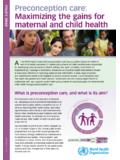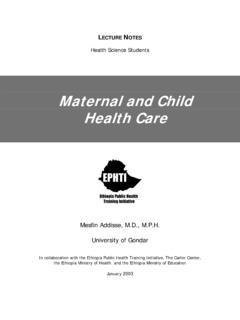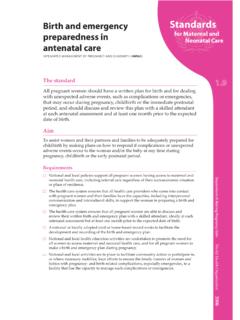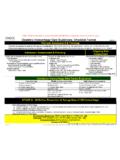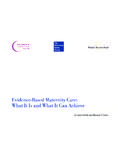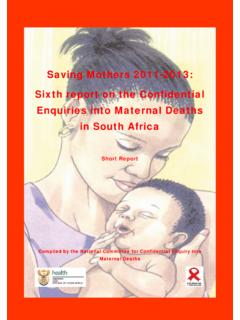Transcription of Maternal Care: A learning programme for professionals
1 Maternal CareMaternal CareA learning programme for professionalsTake control of your own learning in this innovative new book for nurses and doctors. You ll learn to solve practical problems and to take a simple, logical approach to common learning objectives help you understand the most important lessons to be knowledge is presented in an easy, problem-solving , step-by-step guides through definitions, causes, diagnoses, prevention, dangers and studies in story-form let you apply your new knowledge to solve common questions help you monitor your balanced and up-to-date guide to common and important clinical conditions can be used as a training course or as a reference manual for professionals and students. Perinatal Education ProgrammePart of the highly successful Perinatal Education programme , which has brought effective continuing training to thousands of midwives, neonatal nurses and 978 1 920218 27 0 Developed by thePerinatal Education ProgrammeA learningprogramme forprofessionalsMaternal CareMaternal CareA learning programme for professionalsDeveloped by thePerinatal Education IMPORTANTWe have taken every care to ensure that drug dosages and related medical advice in this book are accurate.
2 However, drug dosages can change and are updated often, so always double-check dosages and procedures against a reliable, up-to-date formulary and the given drug s documentation before administering care : A learning programme for professionalsUpdated: 2 June 2010 First published by EBW Healthcare in 2010 Text Perinatal Education programme 2010 Illustrations by Anne WestobyGetup Electric Book Works 2010 ISBN (print edition): 978-1-920218-27-0 ISBN (PDF ebook edition): 978-1-920218-45-4 All text in this book excluding the tests and answers is published under the Creative Commons Attribution Non-Commercial No Derivatives License. You can read up about this license at multiple-choice tests and answers in this publication may not be reproduced, stored in a retrieval system, or transmitted in any form or by any means without the prior permission of Electric Book Works, 87 Station Road, Observatory, Cape Town, our websites at and 7 Introduction 9 About the EBW Healthcare series 9 Why decentralised learning ?
3 9 Books in the EBW Healthcare series 9 Format of the courses 11 Contributors 12 Updating the course material 13 Contact information 131 Antenatal care 15 Goals of good antenatal care 15 Diagnosing pregnancy 16 The first antenatal visit 16 Determining the duration of pregnancy 20 Side-room and special screening investigations 21 The second antenatal visit 23 Assessing the results of the special screening investigations 23 Grading the risk 25 Subsequent visits 26 The visit at 28 weeks 26 The visit at 34 weeks 27 The visit at 41 weeks 27 Managing pregnant women with HIV infection 29 Case study 1 32 Case study 2 33 Case study 3 33 Case study 4 341A Skills workshop: General examination at the first antenatal visit 39 History taking 39 Examination of the patient 41 Testing the patient s urine 42 Doing a pregnancy test 421B Skills workshop: Examination of the abdomen in pregnancy 44 General examination of the abdomen 44 Examination of the uterus and the fetus 451C Skills workshop: Vaginal examination in pregnancy 51 Indications for a vaginal examination 51 Method of vaginal examination 521D Skills workshop: Screening tests for syphilis 54 Syphilis screening 54 Syphilis rapid test 54 The RPR card test 55 Skills workshop: Screening tests for HIV 58 HIV screening 582 Assessment of fetal growth and condition during pregnancy 60 Introduction 60 Fetal growth 61 Fetal movements 65 Antenatal fetal heart rate monitoring 67 Case study 1 71 Case study 2 71 Case study 3 72 Case study 4 732A Skills workshop.
4 Routine use of the antenatal card 783 Hypertensive disorders of pregnancy 84 The hypertensieve disorders of pregnancy 84 The classification of hypertension during pregnancy 85 Pre-eclampsia 86 Patients at increased risk of pre-eclampsia 88 The management of pre-eclampsia 89 The emergency management of severe pre-eclampsia and imminent eclampsia 90 The management of eclampsia 92 The further management of severe pre-eclampsia and imminent eclampsia at the referral hospital 92 Gestational hypertension 94 Chronic hypertension 94 Case study 1 95 Case study 2 96 Case study 3 96 Case study 4 973A Skills workshop: Measuring blood pressure and proteinuria 98 Measuring blood pressure 98 Measuring proteinuria 994 Antepartum haemorrhage 100 Antepartum haemorrhage 100 The initial emergency management of antepartum haemorrhage 101 Diagnosing the cause of the bleeding 103 Antepartum bleeding caused by abruptio placentae 104 Antepartum bleeding caused by placenta praevia 107 Antepartum haemorrhage of unknown cause 111 Referral of a patient with an antepartum haemorrhage 112A blood-stained vaginal discharge 113 Case study 1 114 Case study 2 114 Case study 3 115 Case study 4 1155 Preterm labour and preterm rupture of the membranes 117 Preterm labour and preterm rupture of the membranes 117 Diagnosis of preterm labour and preterm rupture of the membranes 120 Management of preterm labour 122 Management of preterm rupture of the membranes 125 Prelabour rupture of the membranes 128 Case
5 Study 1 129 Case study 2 130 Case study 3 1306 Monitoring the condition of the mother during the first stage of labour 132 Monitoring labour 132 Assessing the general condition of the patient 133 Assessing the temperature 134 Assessing the pulse rate 135 Assessing the blood pressure 136 Assessing the urine 137 Maternal exhaustion 138 Case study 1 139 Case study 2 1397 Monitoring the condition of the fetus during the first stage of labour 140 Monitoring the fetus 140 Fetal heart rate patterns 142 The liquor 146 Case study 1 147 Case study 2 148 Case study 3 1488 The first stage of labour: Monitoring and management 150 The diagnosis of labour 150 The two phases of the first stage of labour 150 Monitoring of the first stage of labour 151 Management of a patient in the latent phase of the first stage of labour 153 Management of a patient in the active phase of the first stage of labour 154 Poor progress in the active phase of the first stage of labour 156 Cephalopelvic disproportion 159 Inadequate uterine action 160 The referral of patients with poor progress during the active phase of the first stage of labour 161 Prolapse of the umbilical cord 161 Case study 1 163 Case study 2 163 Case study 3 164 Case study 4 1648a Skills workshop: Examination of the abdomen in labour 166 Abdominal palpation 166 Assessing contractions 169 Assessing the fetal heart rate 1698B Skills workshop.
6 Vaginal examination in labour 170 Preparation for a vaginal examination in labour 170 Procedure of examination 171 The vulva and vagina 171 The cervix 171 The membranes and liquor 172 The presenting part 172 Moulding 1758C Skills workshop: Recording observations on the partogram 178 The partogram 178 Recording the condition of the mother 178 Recording the condition of the fetus 178 Recording the progress of labour 180 Exercises on the correct use of the partogram 182 Case study 1 182 Case study 2 183 Case study 3 1869 The second stage of labour 189 The normal second stage of labour 189 Managing the second stage of labour 190 Episiotomy 193 Prolonged second stage of labour 193 Management of impacted shoulders 194 Managing the newborn infant 196 Case study 1 196 Case study 2 197 Case study 3 197 Case study 4 1989a Skills workshop: Performing and repairing an episiotomy 199 Performing an episiotomy 199 Repairing an episiotomy 20010 Managing pain during labour 205 Pain relief in labour 205 Use of analgesics in labour 207 Naloxone 208 Sedation during labour 209 Inhalational analgesia 209 Local anaesthesia 210 Epidural anaesthesia 210 General anaesthesia 211 Case study 1 211 Case study 2 212 Case study 3 213 Case study 4 21311 The third stage of labour 215 The normal third stage of labour 215 Managing the third stage of labour 216 Examination of the placenta after birth 219 The abnormal third stage of labour 220 Managing postpartum haemorrhage 221 Protecting the staff from HIV infection 225 Case study 1 226 Case study 2 226 Case study 3 227 Case study 4 22712 The puerperium 229 The normal puerperium 229 Management of the puerperium 231 The six week postnatal visit 234 Puerperal pyrexia 235
7 Thrombophlebitis 237 Respiratory tract infection 237 Puerperal psychiatric disorders 238 Secondary postpartum haemorrhage 239 Self-monitoring 240 Case study 1 240 Case study 2 241 Case study 3 241 Case study 4 242 Case study 1 22713 Medical problems during pregnancy, labour and the puerperium 243 Urinary tract infection during pregnancy 243 Anaemia in pregnancy 246 Heart valve disease in pregnancy and the puerperium 247 Diabetes mellitus in pregnancy 250 Case study 1 252 Case study 2 254 Case study 3 255 Case study 4 25514 Family planning after pregnancy 257 Contraceptive counselling 257 Case study 1 263 Case study 2 264 Case study 3 264 Case study 4 26515 Regionalised perinatal care 266 Regionalised perinatal care 266 The Maternal - care clinic 269 Transferring patients safely to hospital 271 Maternal mortality 272 Case study 1 273 Case study 2 274 Case study 3 274 Appendix 276 Guidelines for the management of patients with risk factors and medical problems during pregnancy, labour and the puerperium 276 Tests 289 AcknowledgementsMaternal care has been edited from the Maternal care manual of the Perinatal Education programme .
8 This learning programme for professionals is developed by the Perinatal Education Trust and funded by acknowledge all the participants of the Perinatal Education programme who have made suggestions and offered constructive criticism over the years. It is only through constant feedback from colleagues and participants that the content of the Perinatal Education programme courses can be of the Perinatal Education programme : Prof D WoodsEditor of Maternal care : Prof G TheronContributors to Maternal care : Prof H van C de Groot, Dr D Greenfield, Ms H Louw, Ms M Petersen, Dr N Rhoda, Prof G Theron, Prof D WoodsIntroductionA b o u t t h e e bW h e A lt hC Ar e s e r i e sEBW Healthcare publishes an innovative series of distance- learning books for healthcare professionals , developed by the Perinatal Education Trust, Eduhealthcare, the Desmond Tutu HIV Foundation and the Desmond Tutu TB Centre, with contributions from numerous aim is to provide appropriate, affordable and up-to-date learning material for healthcare workers in under-resourced areas, so that they can manage their own continuing education courses which will enable them to learn, practise and deliver skillful, efficient patient EBW Healthcare series is built on the experience of the Perinatal Education programme (PEP)
9 , which has provided learning opportunities to over 60 000 nurses and doctors in South Africa since 1992. Many of the educational methods developed by PEP are now being adopted by the World Health Organisation (WHO).W hy d eC e n t rA l i s e d l eA r n i n g? Continuing education for healthcare workers traditionally consists of courses and workshops run by formal trainers at large central hospitals. These teaching courses are expensive to attend, often far away from the healthcare workers families and places of work, and the content frequently fails to address the real healthcare requirements of the poor, rural communities who face the biggest healthcare help solve these many problems, a self-help decentralised learning method has been developed which addresses the needs of professional healthcare workers, especially those in poor, rural o o k s i n t h e e bW h e A lt hC Ar e s e r i e sMaternal care addresses all the common and important problems that occur during pregnancy, labour, delivery and the puerperium.
10 It covers the antenatal and postnatal care of healthy women with normal pregnancies, monitoring and managing 10m a te r n a l c a rethe progress of labour, specific medical problems during pregnancy, labour and the puerperium, family planning and regionalised perinatal care . Skills workshops teach clinical examination in pregnancy and labour, routine screening tests, the use of an antenatal card and partogram, measuring blood pressure, detecting proteinuria and performing and repairing an care is aimed at healthcare workers in level 1 hospitals or Maternal care addresses the needs of healthcare workers who provide antenatal and postnatal care , but do not conduct deliveries. It is adapted from theory chapters and skills workshops from Maternal care . This book is ideal for midwives and doctors providing primary Maternal care in level 1 district hospitals and clinics, and complements the national protocol of antenatal care in South care was developed for doctors and advanced midwives who care for women who deliver in district hospitals.
